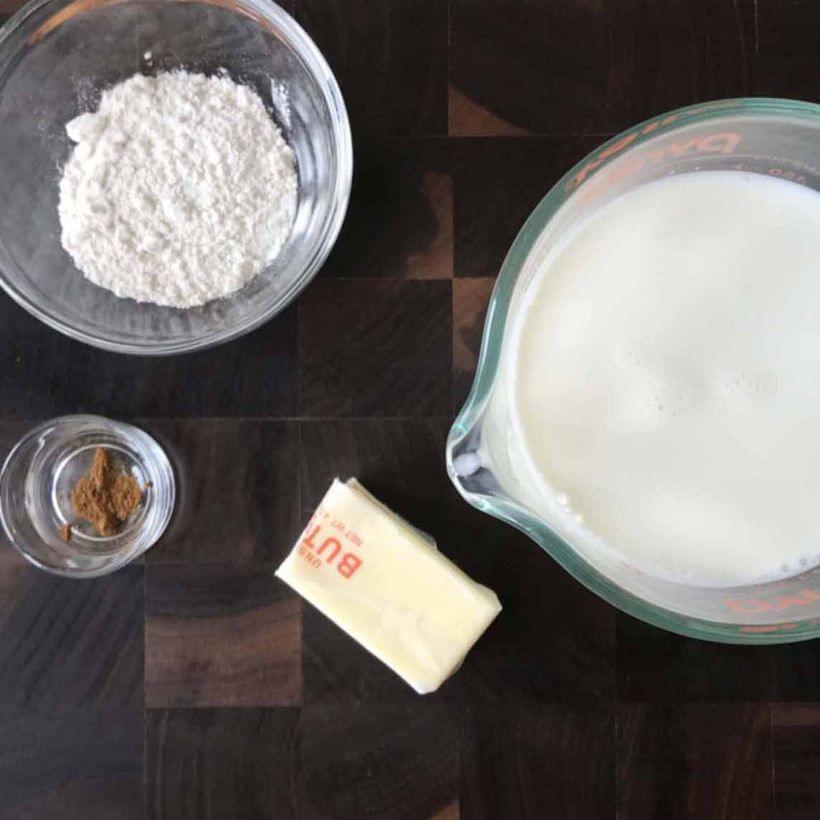Béchamel

Shut up; Julia Child rules.
Okay, don’t— don’t, with that look. I can tell that some of you are out there side-eying this recipe, like I just said “oh ho ho well you simply must know that the secret weapon in the repitoire of any home chef is” followed by some nasty old 1950’s-style aspic in the shape of—but not containing—a fish.
Béchamel is good, and—listen—I am using that accent mark because it is correct, not for purposes hoity nor toity. It’s butter, flour, and milk. It takes like five minutes. It’s easy, and don’t let anyone tell you otherwise. Fully half of the recipe is “make a roux”—which is basically two (2) ingredients, and the second half is “put hot milk in it.” Season it a little, and you’re done.
Speaking of the seasoning, don’t sweat the white pepper too much. It needs pepper—I mean, most things do—but the white pepper is just to avoid visible specks. A couple twists of black pepper will do you just fine, and nobody is out here grading our béchamels on looks.
If you’re making a bone stock béchamel, don’t skip the nutmeg. If you’re looking at the ingredients list thinking “so this is uh hot dense Christmas milk”: by cooking the flour, even minimally, you’re giving it a toasty, nutty flavor. A little nutmeg boosts that, without being obvious. It works.
If you’re not making a bone stock béchamel, swap the nutmeg for a pinch of five-spice. Trust me on this one.
Add grated parmesean and make it a layer in a lasagne. Cook aromatics in the butter before adding the flour, and use it for whatever. Add gruyère, you’ve got a sauce mornay—which might sound pretty fancy, but grating the cheese takes longer than the rest of the recipe combined. Use a white stock instead of milk, and you’ve got a sauce velouté. Boom—you’re two mother sauces deep now; you may as well go out and get a forearm tattoo of a chef’s knife.
Of Roux and Ratios
If nothing else, look at this recipe as an excuse to get good at making a roux—you’re gonna need it for curry rice, you’re gonna need it for croquettes, and you’re gonna need it for chowders and stews.
Just don’t rush the roux part, even if you’re worried about it browning a little on you. Better to have it tip over into “ivory” territory—you can always start another one if it gets too browned on you. Undercooking it could end up lending your final dish a chalky, raw flour taste, and there are no take-backs on that.
The way it was taught to me at Cambridge Culinary There are three on-paper flour to butter ratios, depending on what it is you’re going to be thickening with a roux.
| Application | Flour | Butter |
|---|---|---|
| Soufflés | 3 Tbsp. | 3 Tbsp. |
| Sauces | 2 Tbsp. | 3 Tbsp. |
| Soups | 1 Tbsp. | 3 Tbsp. |
All that said: if I need something thickened quickly, flavorlessly, and without any cloud—like a glossy pan sauce for a stir-fry—I’ll use cornstarch. It’s just a thickening agent, and stays out of my way otherwise.
But a roux thickens while adding the richness of butter and a wide range of toasty flavors, which you can control through the color of the roux. But keep in mind: the darker the roux, the less thickening power it has. That’s why my curry rice recipe uses a 1:1 ratio, even though it doesn’t end up all that thick.
Ingredients
-
3 Tbsp Unsalted butter
-
2 Tbsp All-purpose flour
-
2 C. Milk, any fat content will work
-
A pinch Freshly grated nutmeg
-
Salt and freshly ground white pepper, to taste (black pepper is fine too)
Instructions
Bring the milk up to almost simmering—“the barest suggestion of a simmer,” as Julia Child put it. You want about 190 F on an instant-read—you can eyeball it by looking for a ring of tiny bubbles forming around the inside of the pot. This part isn’t as fussy as it sounds, though, in my experience. Just get the milk uncomfortably hot to the touch; a microwave works fine, just be sure to stop and stir it occasionally.
Meanwhile, melt the butter in a 3 quart saucepan over medium heat. Once fully liquified, add the flour, whisking constantly. Once the foaming subsides, add about a half cup of the hot milk in a thin stream, whisking vigorously.
After a few moments, it should form something best described as “mashed-potato-esque.” Add the rest of the milk in increments, whisking vigorously.
Add grated nutmeg, salt, and pepper to taste. Reduce heat to low, and keep warm until needed.